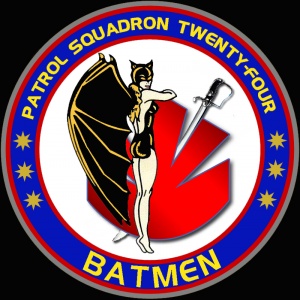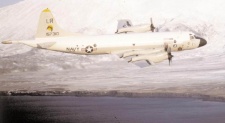Maquis SIM Project/Fighters/VP-24
| Line 7: | Line 7: | ||
'''History and Squadron Insignia/Nickname'''<br> | '''History and Squadron Insignia/Nickname'''<br> | ||
---- | ---- | ||
| − | MFI's Patrol Squadron TWENTY-FOUR (VP-24) carries the name of a late twentieth century squadron established during the second world war. The first squadron insignia on record was designed for VP-HL-4 and was approved by CNO on 9 July 1947. The theme of the design was based on the Bat, or Special Weapons Ordnance Device (SWOD) Mark 9, a radio-controlled glide bomb assigned to the squadron in 1946. Although the weapon was redesignated ASMN-2 after the war, it was still affectionately called the Bat by the few squadrons carrying it. The design consisted of a yellow bat superimposed on a large red figure 4 on a circular field of blue. The bat, clutching a large bomb, and with lightning flashing from its eyes, signified the mission of the squadron and the electronic nature of the device. In the upper left of the circular field of blue there was a silhouette of a PB4Y-2 Privateer, the aircraft assigned to the squadron. Colors: background, medium blue; bat, yellow; bat’s eyes and mouth, red; bomb, white; lightning bolts, white; aircraft silhouette, white; letters, red. The insignia remained in use from 1946 to 1948. The second squadron insignia was submitted when the mission of the squadron changed from Bat glide bombs to ASW, reconnaissance and antishipping in 1950. The squadron was so fond of the designation Batmen, that permission was requested to retain the symbolism in the new design. Upon approval by CNO on 23 January 1951, this insignia became unique as the only authorized naval squadron insignia displaying a member of the female sex. The Batgirl was depicted leaning against a heraldic shield superimposed over a naval officer’s sword. On the shield was a homing torpedo suspended by parachute over a periscope emerging from the ocean depths. Colors: Batgirl, black wings and outfit; skin, flesh color; shield, red border with white background; sea, blue; periscope, white; torpedo, black and white with red parachute; sword, red pommel and blade with gold tassel; VP-24 letters, black on white background in scroll at bottom of design. The insignia was used by VP-24 from 1951 until the squadron was disestablished in 1995.<br> | + | [[Image:Clip 2.jpg|275px|thumb|100px|VP-HL-4]] |
| − | + | [[Image:Vp-24 orig.jpg|thumb|100px|VP-24]] | |
| − | + | MFI's Patrol Squadron TWENTY-FOUR (VP-24) carries the name of a late twentieth century squadron established during the second world war. The first squadron insignia on record was designed for VP-HL-4 and was approved by CNO on 9 July 1947. The theme of the design was based on the Bat, or Special Weapons Ordnance Device (SWOD) Mark 9, a radio-controlled glide bomb assigned to the squadron in 1946. Although the weapon was redesignated ASMN-2 after the war, it was still affectionately called the Bat by the few squadrons carrying it. The design consisted of a yellow bat superimposed on a large red figure 4 on a circular field of blue. The bat, clutching a large bomb, and with lightning flashing from its eyes, signified the mission of the squadron and the electronic nature of the device. In the upper left of the circular field of blue there was a silhouette of a PB4Y-2 Privateer, the aircraft assigned to the squadron. Colors: background, medium blue; bat, yellow; bat’s eyes and mouth, red; bomb, white; lightning bolts, white; aircraft silhouette, white; letters, red. The insignia remained in use from 1946 to 1948. The second squadron insignia was submitted when the mission of the squadron changed from Bat glide bombs to ASW, reconnaissance and antishipping in 1950. The squadron was so fond of the designation Batmen, that permission was requested to retain the symbolism in the new design. Upon approval by CNO on 23 January 1951, this insignia became unique as the only authorized naval squadron insignia displaying a member of the female sex. The Batgirl was depicted leaning against a heraldic shield superimposed over a naval officer’s sword. On the shield was a homing torpedo suspended by parachute over a periscope emerging from the ocean depths. Colors: Batgirl, black wings and outfit; skin, flesh color; shield, red border with white background; sea, blue; periscope, white; torpedo, black and white with red parachute; sword, red pommel and blade with gold tassel; VP-24 letters, black on white background in scroll at bottom of design. The insignia was used by VP-24 from 1951 until the squadron was disestablished in 1995.<br><br> | |
<div align=left> | <div align=left> | ||
MFI's VP-24 insignia is one which takes many elements of her 20th century namesake. Replacing the shield with one of Maquis origin, this remains very recognizable as that of the Batmen!<br><br> | MFI's VP-24 insignia is one which takes many elements of her 20th century namesake. Replacing the shield with one of Maquis origin, this remains very recognizable as that of the Batmen!<br><br> | ||
| Line 15: | Line 15: | ||
'''Aircraft'''<br> | '''Aircraft'''<br> | ||
---- | ---- | ||
| − | At the time of is disestablishment in the 20th century, VP-24 flew the P-3C. | + | [[Image:Clip.jpg|thumb|225px|P-3C Orion]] |
| − | < | + | |
| + | At the time of is disestablishment in the 20th century, VP-24 flew the P-3C Orion, based on the Lockheed L-188 Electra which met limited success as an airliner against emerging pure jets. It served as the replacement for the postwar era P-2 Neptune which was powered by 2 piston engines and 2 jets. The Orion was powered by 4 powerful and efficient turboprops which give it speed comparable to fast propeller powered fighters, or even slow turbofan jets such as the A-10. Most other similar patrol aircraft adopted this model, with Soviets adapting their own counterpart to the Electra. The P-3C also competed with the British Nimrod adaption of the Comet. Experience with the P-3C helped with the S-3 Viking carrier-borne ASW jet. The P-3C had an internal bomb bay under the front fuselage, as well as underwing stations which it could carry missiles such as the AGM-84 Harpoon. It had a characteristic long stinger in the tail which housed the MAD magnetic detector, and domed windows for observation. Sonobuoys could be dropped from externally loaded tubes, or from inside the fuselage.<br><br> | ||
<div align=left> | <div align=left> | ||
'''Spacecraft'''<br> | '''Spacecraft'''<br> | ||
---- | ---- | ||
Today, MFI's VP-24 is made up of nine Maquis Ju'Day Raider Class starships. These modified transports have been outfitted with weaponry and a variety of other mission specific eqipment. Specicificallly tasked to Patrol the Badlands and established Maquis bases, VP-24's Raiders are mostly outfitted with special and highly tuned sensor equipment designed to serve as early warning for attacks or detecting hostile forces in areas in which the Maquis operate. Although not intended for combat but rather long and deep patrols in and around Maquis territory, the Raiders of VP-24 are armed to defend themselves and the assets they protect and patrol near. | Today, MFI's VP-24 is made up of nine Maquis Ju'Day Raider Class starships. These modified transports have been outfitted with weaponry and a variety of other mission specific eqipment. Specicificallly tasked to Patrol the Badlands and established Maquis bases, VP-24's Raiders are mostly outfitted with special and highly tuned sensor equipment designed to serve as early warning for attacks or detecting hostile forces in areas in which the Maquis operate. Although not intended for combat but rather long and deep patrols in and around Maquis territory, the Raiders of VP-24 are armed to defend themselves and the assets they protect and patrol near. | ||
Revision as of 21:29, 3 June 2006

Patrol Squadron (VP) 24
"Batmen"
History and Squadron Insignia/Nickname
MFI's Patrol Squadron TWENTY-FOUR (VP-24) carries the name of a late twentieth century squadron established during the second world war. The first squadron insignia on record was designed for VP-HL-4 and was approved by CNO on 9 July 1947. The theme of the design was based on the Bat, or Special Weapons Ordnance Device (SWOD) Mark 9, a radio-controlled glide bomb assigned to the squadron in 1946. Although the weapon was redesignated ASMN-2 after the war, it was still affectionately called the Bat by the few squadrons carrying it. The design consisted of a yellow bat superimposed on a large red figure 4 on a circular field of blue. The bat, clutching a large bomb, and with lightning flashing from its eyes, signified the mission of the squadron and the electronic nature of the device. In the upper left of the circular field of blue there was a silhouette of a PB4Y-2 Privateer, the aircraft assigned to the squadron. Colors: background, medium blue; bat, yellow; bat’s eyes and mouth, red; bomb, white; lightning bolts, white; aircraft silhouette, white; letters, red. The insignia remained in use from 1946 to 1948. The second squadron insignia was submitted when the mission of the squadron changed from Bat glide bombs to ASW, reconnaissance and antishipping in 1950. The squadron was so fond of the designation Batmen, that permission was requested to retain the symbolism in the new design. Upon approval by CNO on 23 January 1951, this insignia became unique as the only authorized naval squadron insignia displaying a member of the female sex. The Batgirl was depicted leaning against a heraldic shield superimposed over a naval officer’s sword. On the shield was a homing torpedo suspended by parachute over a periscope emerging from the ocean depths. Colors: Batgirl, black wings and outfit; skin, flesh color; shield, red border with white background; sea, blue; periscope, white; torpedo, black and white with red parachute; sword, red pommel and blade with gold tassel; VP-24 letters, black on white background in scroll at bottom of design. The insignia was used by VP-24 from 1951 until the squadron was disestablished in 1995.
MFI's VP-24 insignia is one which takes many elements of her 20th century namesake. Replacing the shield with one of Maquis origin, this remains very recognizable as that of the Batmen!
Aircraft
At the time of is disestablishment in the 20th century, VP-24 flew the P-3C Orion, based on the Lockheed L-188 Electra which met limited success as an airliner against emerging pure jets. It served as the replacement for the postwar era P-2 Neptune which was powered by 2 piston engines and 2 jets. The Orion was powered by 4 powerful and efficient turboprops which give it speed comparable to fast propeller powered fighters, or even slow turbofan jets such as the A-10. Most other similar patrol aircraft adopted this model, with Soviets adapting their own counterpart to the Electra. The P-3C also competed with the British Nimrod adaption of the Comet. Experience with the P-3C helped with the S-3 Viking carrier-borne ASW jet. The P-3C had an internal bomb bay under the front fuselage, as well as underwing stations which it could carry missiles such as the AGM-84 Harpoon. It had a characteristic long stinger in the tail which housed the MAD magnetic detector, and domed windows for observation. Sonobuoys could be dropped from externally loaded tubes, or from inside the fuselage.
Spacecraft
Today, MFI's VP-24 is made up of nine Maquis Ju'Day Raider Class starships. These modified transports have been outfitted with weaponry and a variety of other mission specific eqipment. Specicificallly tasked to Patrol the Badlands and established Maquis bases, VP-24's Raiders are mostly outfitted with special and highly tuned sensor equipment designed to serve as early warning for attacks or detecting hostile forces in areas in which the Maquis operate. Although not intended for combat but rather long and deep patrols in and around Maquis territory, the Raiders of VP-24 are armed to defend themselves and the assets they protect and patrol near.


